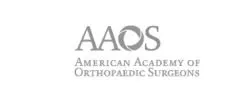Arthritis of the Knee
Knee arthritis can make it hard to do many everyday activities, such as walking or climbing stairs. It is a major cause of lost work time and a serious disability for many people.
The most common types of arthritis are osteoarthritis and rheumatoid arthritis, but there are more than 100 different forms. While arthritis is mainly an adult disease, some forms affect children.
Although there is no cure for arthritis, there are many treatment options available to help manage pain and keep people staying active.
Anatomy
The knee is the largest and strongest joint in your body. It is made up of the lower end of the femur (thighbone), the upper end of the tibia (shinbone), and the patella (kneecap). The ends of the three bones that form the knee joint are covered with articular cartilage, a smooth, slippery substance that protects and cushions the bones as you bend and straighten your knee.
Two wedge-shaped pieces of cartilage called meniscus act as “shock absorbers” between your thighbone and shinbone. They are tough and rubbery to help cushion the joint and keep it stable.
The knee joint is surrounded by a thin lining called the synovial membrane. This membrane releases a fluid that lubricates the cartilage and reduces friction.
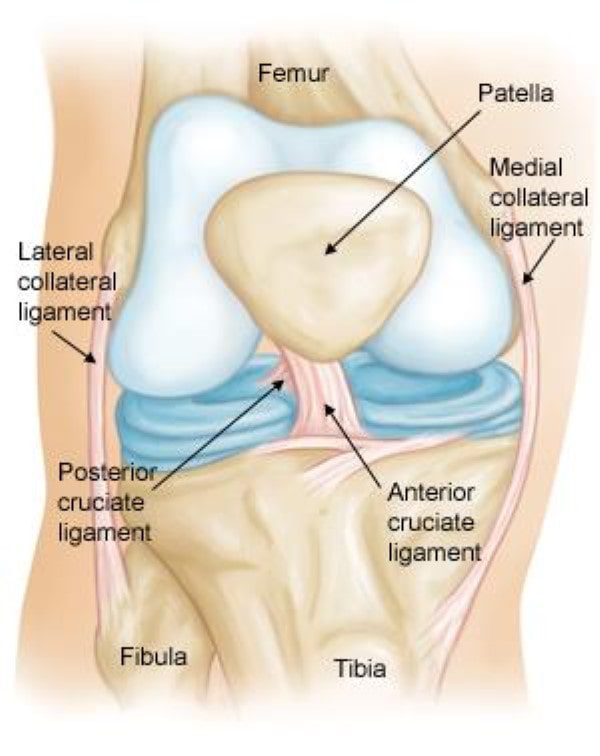
Description
The major types of arthritis that affect the knee are osteoarthritis, rheumatoid arthritis, and posttraumatic arthritis.
Osteoarthritis
Osteoarthritis is the most common form of arthritis in the knee. It is a degenerative, “wear-and-tear” type of arthritis that occurs most often in people 50 years of age and older, although it may occur in younger people, too.
In osteoarthritis, the cartilage in the knee joint gradually wears away. As the cartilage wears away, it becomes frayed and rough, and the protective space between the bones decreases. This can result in bone rubbing on bone and produce painful bone spurs.
Osteoarthritis usually develops slowly and the pain it causes worsens over time.
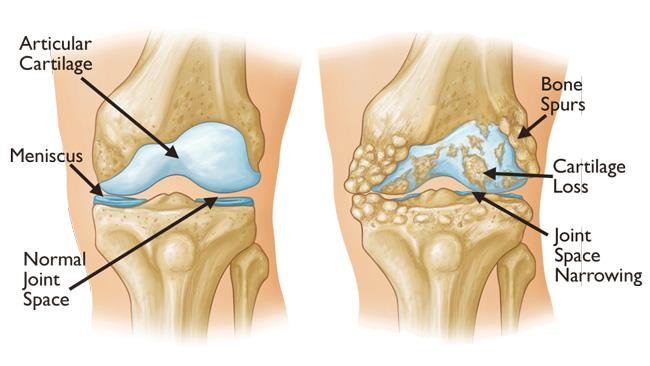
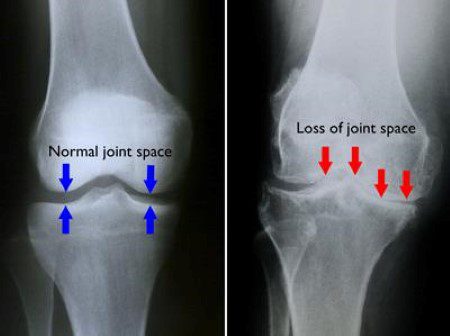
Laboratory Tests
Your doctor may also recommend blood tests to determine which type of arthritis you have. With some types of arthritis, including rheumatoid arthritis, blood tests will help with a proper diagnosis.
Treatment
Nonsurgical Treatment
As with other arthritic conditions, initial treatment of arthritis of the knee is nonsurgical. Your doctor may recommend a range of treatment options.
Lifestyle modifications. Some changes in your daily life can protect your knee joint and slow the progress of arthritis.
- Minimize activities that aggravate the condition, such as climbing stairs.
- Exercise is recommended for osteoarthritis to improve pain and function. Switching from high-impact activities (like jogging or tennis) to lower impact activities (like swimming or cycling) will enable you to be active while putting less stress on your knee. Balance, agility, and coordination exercises, combined with traditional exercise, may help to improve function and walking speed.
- Losing weight can reduce stress on the knee joint, resulting in less pain and increased function.
Physical therapy. Specific exercises can help increase range of motion and flexibility, as well as help strengthen the muscles in your leg. Your doctor or a physical therapist can help develop an individualized exercise program that meets your needs and lifestyle.
Assistive devices. Using devices such as a cane, or wearing a brace or knee sleeve can be helpful. A brace assists with stability and function, and it may be especially helpful if the arthritis is centered on one side of the knee. There are two types of braces that are often used for knee arthritis: An “unloader” brace shifts weight away from the affected portion of the knee, while a “support” brace helps support the entire knee load. Placing wedges in your shoe is not recommended for relieving knee discomfort.
Other remedies. Applying heat or ice, or wearing elastic bandages to provide support to the knee may provide some relief from pain.
Medications. Several types of drugs are useful in treating arthritis of the knee. Because people respond differently to medications, your doctor will work closely with you to determine the medications and dosages that are safe and effective for you.
- Over-the-counter, non-narcotic pain relievers and anti-inflammatory medications are usually the first choice of therapy for arthritis of the knee. Like all medications, over-the-counter pain relievers can cause side effects and interact with other medications you are taking. Be sure to discuss potential side effects with your doctor.
- Another type of pain reliever is a nonsteroidal anti-inflammatory drug, or NSAID (pronounced “en-said”). NSAIDs, such as ibuprofen and naproxen, are available both over-the-counter and by prescription and in oral and topical (gel) forms. Oral NSAIDs are recommended to improve pain and function in people with knee osteoarthritis. However, NSAIDs should be used with caution, or avoided, in people with certain health conditions, such as coronary artery disease, congestive heart failure, and chronic kidney disease. Talk to your doctor about whether NSAIDs are right for you. Acetaminophen is a simple, over-the-counter pain reliever that can be effective in reducing arthritis pain, especially for people who cannot tolerate traditional NSAIDs.
- A COX-2 inhibitor is a special type of NSAID that may cause fewer gastrointestinal side effects. Common brand names of COX-2 inhibitors include Celebrex (celecoxib) and Mobic (meloxicam, which is a partial COX-2 inhibitor). A COX-2 inhibitor reduces pain and inflammation so that you can function better. If you are taking a COX-2 inhibitor, you should not use a traditional NSAID (prescription or over-the-counter). Be sure to tell your doctor if you have had a heart attack, stroke, angina, blood clot, or hypertension, or if you are sensitive to aspirin, sulfa drugs, or other NSAIDs.
- Topical NSAIDs are also available for the treatment of knee pain. There is a strong recommendation to try this type of treatment for pain control, especially if you are unable to tolerate oral NSAIDs.
- The use of oral narcotic medications, including opioids, should be avoided. This class of medications is not effective for the treatment of pain due to knee arthritis.
- Corticosteroids (also known as cortisone) are powerful anti-inflammatory agents that can be injected into the joint. These injections can provide pain relief and reduce inflammation; however, the effects do not last indefinitely. Your doctor may recommend limiting the number of injections to three or four per year, per joint, due to possible side effects. In some cases, pain and swelling may flare immediately after the injection, and the potential exists for long-term joint damage or infection. With frequent repeated injections, or injections over an extended period of time, joint damage can actually increase rather than decrease.
- Disease-modifying anti-rheumatic drugs (DMARDs) are used to slow the progression of rheumatoid arthritis. Drugs like methotrexate, sulfasalazine, and hydroxychloroquine are commonly prescribed. In addition, biologic DMARDs like etanercept (Enbrel) and adalimumab (Humira) may reduce the body’s overactive immune response. Because there are many different drugs today for rheumatoid arthritis, a rheumatology specialist is often required to effectively manage medications.
- Glucosamine and chondroitin sulfate, substances found naturally in joint cartilage, can be taken as dietary supplements. Although patient reports indicate that these supplements may relieve pain, there is no evidence to support the use of glucosamine and chondroitin sulfate to decrease or reverse the progression of arthritis. In addition, the U.S. Food and Drug Administration does not test dietary supplements before they are sold to consumers. These compounds may cause side effects, as well as negative interactions with other medications. Always consult your doctor before taking dietary supplements.
Alternative therapies. Many alternative forms of therapy are unproven, but may be helpful to try, provided you find a qualified practitioner and keep your doctor informed of your decision. Alternative therapies to treat pain include the use of acupuncture, magnetic pulse therapy, platelet-rich plasma, and stem cell injections.
Acupuncture uses fine needles to stimulate specific body areas to relieve pain or temporarily numb an area. Although it is used in many parts of the world and evidence suggests that it can help ease the pain of arthritis, there are few scientific studies of its effectiveness. Be sure your acupuncturist is certified, and do not hesitate to ask about his or her sterilization practices.
Magnetic pulse therapy is painless and works by applying a pulsed signal to the knee, which is placed in an electromagnetic field. Like many alternative therapies, magnetic pulse therapy has yet to be proven.
Biologic treatments such as platelet-rich plasma (PRP) and stem cell injections involve taking cells from your own body and re-injecting them into a painful joint.
- PRP uses a component of your own blood, platelets, that have been separated from your blood, concentrated, and injected into your knee. The platelets contain “growth factors” thought to be helpful in reducing the symptoms of inflammation.
- Stem cells are precursor cells that can also be taken from your own body and injected into your knee. Since they are basic cells, they may have the potential to grow into new tissue and thus heal damaged joint surfaces.
While both treatments show promise, clinical studies have yet to confirm their value in treating osteoarthritis.
There is no benefit from Laser Therapy. It is a placebo at best.
Surgical Treatment
Your doctor may recommend surgery if your pain from arthritis causes disability and is not relieved with nonsurgical treatment. As with all surgeries, there are some risks and possible complications with different knee procedures. Your doctor will discuss the possible complications with you before your operation.
Arthroscopy. During arthroscopy, doctors use small incisions and thin instruments to diagnose and treat joint problems.
Arthroscopic surgery is not often used to treat arthritis of the knee. In cases where osteoarthritis is accompanied by a degenerative meniscal tear, arthroscopic surgery may be recommended to treat the torn meniscus.
Cartilage grafting (cartilage restoration). Normal, healthy cartilage tissue may be taken from another part of the knee or from a tissue bank to fill a hole in the articular cartilage. This procedure is typically considered only for younger patients who have small areas of cartilage damage.
Synovectomy. The joint lining damaged by rheumatoid arthritis is removed to reduce pain and swelling.
Osteotomy. In a knee osteotomy, either the tibia (shinbone) or femur (thighbone) is cut and then reshaped to relieve pressure on the knee joint. Knee osteotomy is used when you have early-stage osteoarthritis that has damaged just one side of the knee joint. By shifting your weight off the damaged side of the joint, an osteotomy can relieve pain and significantly improve function in your arthritic knee.
Total knee replacement or partial (unicompartmental) knee replacement (arthroplasty). Your doctor will remove the damaged cartilage and bone, and then position new metal or plastic joint surfaces to restore the function of your knee.
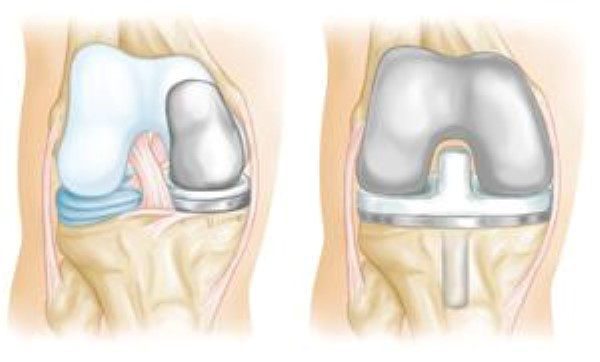
Recovery
Your doctor may recommend physical therapy to help you regain strength in your knee and to restore range of motion. Depending upon your procedure, you may need to wear a knee brace, or use crutches or a cane for a time.
In most cases, surgery relieves pain and makes it possible to perform daily activities more easily.
To assist doctors in the nonsurgical management of knee osteoarthritis, the American Academy of Orthopaedic Surgeons has conducted research to provide some useful guidelines. These are recommendations only and may not apply to every case. For more information: Osteoarthritis of the Knee – Clinical Practice Guideline (CPG) | American Academy of Orthopaedic Surgeons (aaos.org)











